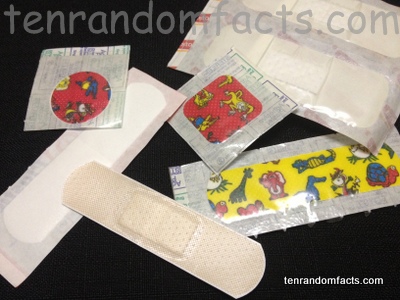Sticky, sticky, adhesive bandages.
- ‘Adhesive bandages’ are also known as ‘sticker plaster’ or ‘sticking plaster’, but are often known by brand names such as ‘Band-Aid’ and ‘Elastoplast’.
- Adhesive bandages are used to guard small cuts from foreign objects or particles as well as extra damage to the cut.
- Adhesive bandages often hold cuts together to quicken the process of healing the cut.
- Adhesive bandages are typically plastic, fabric or rubber strips that are coated with a special adhesive to stick to the skin and have a pad to absorb moisture from the wound.
- Blue, waterproof adhesive bandages are often used by those working in kitchens or the food industry, as they are less likely of losing the adhesive’s stickiness as well as increasing the likeliness of spotting the bandage if it falls off.

- Adhesive bandages come in all different shapes and sizes, and can have adhesive that is quite sticky, flexible or stretchy.
- Adhesive bandages, once removed, can leave a sticky residue on your skin, which is said to be able to be removed by rubbing with moisturiser, baby oil, rubbing alcohol, vinegar or vegetable oil.
- The first adhesive bandages were invented by Earle Dickson in 1920, for his wife, which his employer, Johnson & Johnson then started making commercially and called them a ‘Band-Aid’.
- Some people are allergic to the chemicals used in the glue of an adhesive bandage, and a significant portion of people will develop a skin rash from the bandage if left on for more than a short time.
- Adhesive bandages often stick and bond with the hairs on the skin, so the removal of the bandage can sometimes be quite painful.





I’m one of your relatives who is allergic to them!